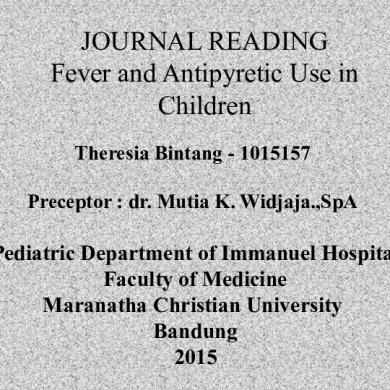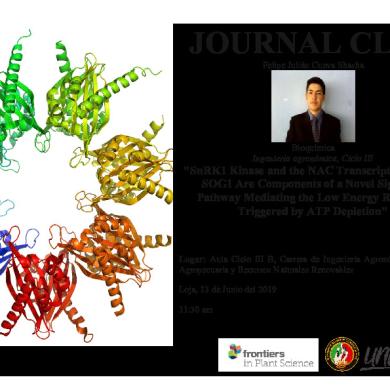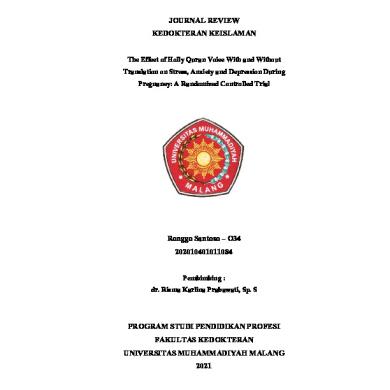* The preview only shows a few pages of manuals at random. You can get the complete content by filling out the form below.
Description
JOURNAL READING Fever and Antipyretic Use in Children Theresia Bintang - 1015157 Preceptor : dr. Mutia K. Widjaja.,SpA
Pediatric Department of Immanuel Hospital Faculty of Medicine Maranatha Christian University Bandung 2015
Introduction • Fever in a child is one of the most common clinical symptoms managed by pediatricians and other health care providers and a frequent cause of parental concern. • Many parents administer antipyretics even when there is minimal or no fever, because they are concerned that the child must maintain a “normal” temperature.
• Approximately onehalf of parents consider a temperature of less than 38°C (100.4°F) to be a fever, and 25% of caregivers would give antipyretics for temperatures of less than 37.8°C (100°F). Furthermore, 85% of parents (n 340) reported awakening their child from sleep to give antipyretics. • Unfortunately, as many as one-half of parents administer incorrect doses of antipyretics; approximately 15% of parents give supratherapeutic doses of acetaminophen or ibuprofen.
• The most common indications for initiating antipyretic therapy by pediatricians are a temperature higher than 38.3°C and improving the child’s overall comfort. • Most pediatricians (80%) believe that a sleeping ill child should not be awakened solely to be given antipyretics. • Antipyretic therapy will remain a common practice by parents and is generally encouraged and supported by pediatricians. Thus, pediatricians and health care providers are responsible for the appropriate counseling of parents and other caregivers about fever and the use of antipyretics.
Physiology of Fever
Treatment Goals • A primary goal of treating the febrile child should be to improve the child’s overall comfort. • Some supporting data from research, that febrile children have altered activity, sleep, and behavior in addition to decreased oral intake.
• Furthermore, antipyretics have other clinical outcomes, including analgesia, which may enhance their overall clinical effect. • Regardless of the exact mechanism of action, many physicians continue to encourage the use of antipyretics with the belief that most of the benefits are the result of improved comfort and the accompanying improvements in activity and feeding, less irritability, and a more reliable sense of the child’s overall clinical condition.
• There is no evidence that reducing fever reduces morbidity or mortality from a febrile illness. • There is no evidence that antipyretic therapy decreases the recurrence of febrile seizures. • Many pediatricians recommend the routine practice of pretreatment with acetaminophen or ibuprofen before a patient receives immunizations to decrease the discomfort associated with the injections and subsequently at the injection sites and to minimize the febrile response. • Furthermore, at this time, there is no evidence that temperature reduction, in and of itself, should be the primary goal of antipyretic therapy.
Antipyretic Information
• In a convenience sample survey of 256 parents or caregivers, 67% reported alternating acetaminophen and ibuprofen for fever control, 81% of whom stated that they had followed the advice of their health care provider or pediatrician. • 4 or more hours after the initiation of treatment, lower temperature was consistently observed in the combination treatment groups. • 6 and 8 hours after the initiation of the study, a greater percentage of children were afebrile in the combination group 83% and 81%, respectively compared with those in the group that received ibuprofen alone (58% and 35%, respectively).
Summary • In contrast, fever may actually be of benefit; thus, the real goal of antipyretic therapy is not simply to normalize body temperature but to improve the overall comfort and well-being of the child. • Acetaminophen and ibuprofen, when used in appropriate doses, are generally regarded as safe and effective agents in most clinical situations. • Combination therapy with acetaminophen and ibuprofen may place infants and children at increased risk because of dosing errors and adverse outcomes, and these potential risks must be carefully considered.
• When counseling a family on the management of fever in a child, pediatricians and other health care providers should minimize fever phobia and emphasize that antipyretic use does not prevent febrile seizures. • Pediatricians should focus instead on monitoring for signs/symptoms of serious illness, improving the child’s comfort by maintaining hydration, and educating parents on the appropriate use, dosing, and safe storage of antipyretics.
THANKYOU













